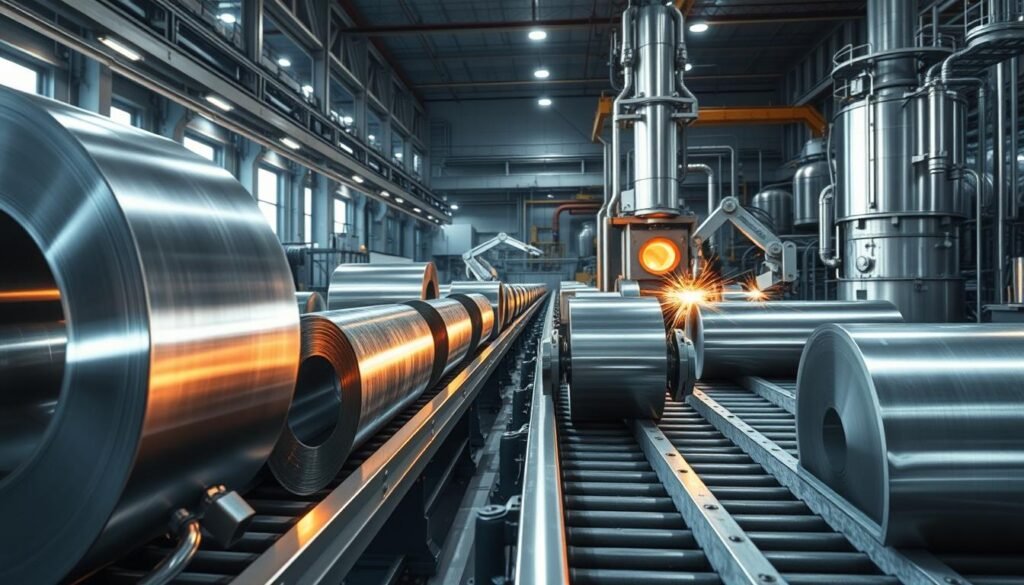High-quality kitchenware and flatware often feature 18/10 stainless steel, a durable and corrosion-resistant alloy. This premium material is composed of 18% chromium and 10% nickel, with the remainder being primarily iron.
The addition of chromium and nickel enhances the resistance to corrosion and provides a shiny finish. The specific formulation of 18/10 stainless steel optimizes its performance characteristics, making it a popular choice for consumer and commercial applications.
As a result, understanding the composition and properties of this grade of stainless steel is crucial for making informed decisions when selecting kitchenware.
Understanding 18/10 Stainless Steel Composition
To grasp the significance of 18/10 stainless steel, it’s crucial to delve into its chemical makeup. The numbers ’18/10′ refer to the percentages of key elements that make up this alloy.
The Meaning Behind the Numbers
The ’18’ in 18/10 stainless steel represents the percentage of chromium content, which is vital for its corrosion resistance. The ’10’ signifies the percentage of nickel, contributing to its durability and aesthetic appeal. The remaining percentage is primarily iron, with trace amounts of other elements.
How 18/10 Stainless Steel is Manufactured
The manufacturing process of 18/10 stainless steel involves several precise steps. Initially, raw materials including iron, chromium, and nickel are measured and mixed. These are then melted in an electric arc furnace at extremely high temperatures.

The molten steel undergoes decarburization to reduce carbon content, enhancing its corrosion resistance. After refining, the steel is cast into semi-finished forms, which are then processed through various operations to achieve the desired product dimensions and surface characteristics.
This meticulous process ensures that the final product meets the high standards required for 18/10 stainless steel, making it a preferred choice among manufacturers and consumers alike.
Properties and Benefits of 18/10 Stainless Steel
18/10 stainless steel is renowned for its outstanding characteristics that make it ideal for a range of uses, particularly in cookware. Its unique combination of properties provides numerous benefits that enhance its performance and durability.
Superior Corrosion and Rust Resistance
The high chromium content in 18/10 stainless steel grants it exceptional resistance to corrosion and rust. This means that it can withstand exposure to moisture and various culinary substances without degrading, ensuring a long-lasting and hygienic cooking surface.
Durability and Longevity
18/10 stainless steel is known for its durability and longevity. It can withstand the rigors of frequent use and cleaning without losing its structural integrity or aesthetic appeal. This durability makes it a cost-effective choice for cookware and other applications.
Heat Resistance and Thermal Properties
The material’s heat resistance and thermal properties are particularly noteworthy. 18/10 stainless steel can maintain its structural integrity at temperatures up to 1598°F (870°C), making it suitable for various cooking methods, including stovetop, oven, induction, gas, electric, and open flame. Its thermal stability ensures that it resists warping and deformation even when subjected to rapid temperature changes. While stainless steel is not an excellent heat conductor on its own, when combined with aluminum or copper cores in cookware, it provides optimal heat distribution. This versatility allows a single pot or pan to be used for multiple cooking techniques, from searing to simmering.
The benefits of 18/10 stainless steel’s heat resistance and thermal properties make it an ideal material for cookware, such as pots and pans, that can be used across different cooking methods and conditions.
Comparing 18/10 with Other Stainless Steel Grades
Stainless steel comes in multiple grades, and understanding the differences between them is crucial for making informed decisions. The most common grades are 18/10, 18/8, and 18/0, each with its own set of characteristics and applications.
18/10 vs. 18/8 Stainless Steel
The primary difference between 18/10 and 18/8 stainless steel lies in their composition. 18/10 contains 10% nickel, while 18/8 contains 8% nickel. This difference affects their corrosion resistance and durability. 18/10 stainless steel offers superior corrosion resistance due to its higher nickel content, making it ideal for high-end applications.
18/10 vs. 18/0 Stainless Steel
18/0 stainless steel, with 0% nickel, is the most budget-friendly option but lacks the corrosion resistance and shine of 18/10 and 18/8. It’s suitable for budget flatware and infrequently used items. In contrast, 18/10 is recommended for premium flatware and high-end cookware where maximum corrosion resistance is essential.
When to Choose Each Grade
The choice of grade depends on the intended application and budget. For commercial food service operations, 18/10 stainless steel is a worthwhile investment due to its longevity and reduced replacement costs. For mid-range applications, 18/8 offers a balance of performance and value.
| Grade | Nickel Content | Corrosion Resistance | Recommended Use |
|---|---|---|---|
| 18/10 | 10% | High | Premium flatware, high-end cookware |
| 18/8 | 8% | Good | Mid-range applications |
| 18/0 | 0% | Low | Budget flatware, infrequently used items |

Common Applications of 18/10 Stainless Steel
The versatility of 18/10 stainless steel makes it a preferred material for various high-end applications. Its unique combination of durability, corrosion resistance, and aesthetic appeal makes it an ideal choice for industries where performance and appearance are crucial.
Premium kitchen flatware and cookware are among the most common applications, where 18/10 stainless steel’s corrosion resistance and durability ensure a long lifespan. Professional-grade cookware often features 18/10 stainless steel cooking surfaces bonded to heat-conducting cores for optimal heat distribution.
Beyond cookware, 18/10 stainless steel is used in commercial kitchen equipment, medical and laboratory instruments, architectural applications, high-end appliances, and food processing equipment due to its sanitary properties, non-reactive surface, and ability to withstand extreme temperatures.
The premium price of 18/10 stainless steel products is justified by their exceptional longevity, often remaining functional and attractive for decades. This makes them a cost-effective choice in the long run, despite a higher initial cost.
